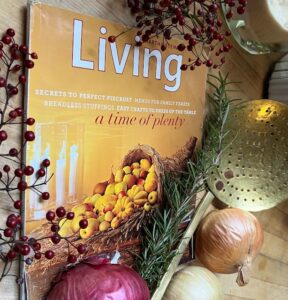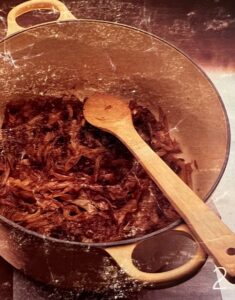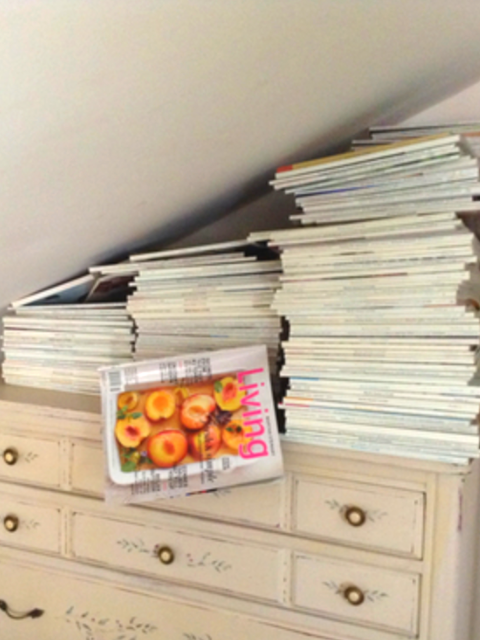
I give lots and lots of advice about decorating, but now need some myself. I simply don’t know what to do with magazine clutter, specifically all my Martha Stewart Living magazines. We have over twenty years worth and they are taking up a lot of space and emitting an explosion of magazine clutter.
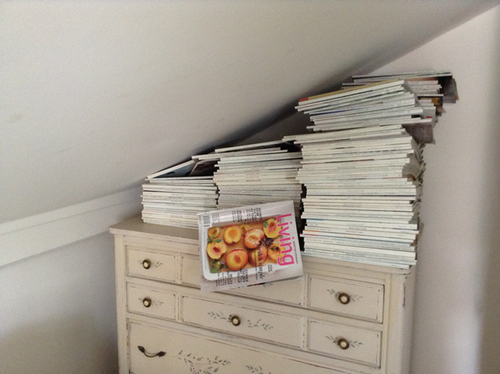
As a designer, I need them. To me, Martha is the queen of good taste. There is something about her decorating that evokes a graceful scaffolding, an energy to all aesthetic endeavors.
Unlike some decorating magazines, which are all about status, many of the articles in Martha Stewart Living teach beauty.
Yet, over 250 “Marthas” in my home are doing just the opposite of what the magazine aspires to do. I know I should get rid of them. We can’t bear, however, to throw them away, sell them or donate them to a nursing home. There might be a special decorating hint, idea or recipe lurking between each cover. Friends have said, “You can get everything online.” Not so, I’m afraid. I learned that the hard way when I was in the NYC apartment planning to make my favorite version of Martha’s onion soup. I realized I’d left the recipe at the country house. It was assumed I could find it on Martha’s site. Plenty of onion soup recipes are posted there, but not the amazing one from the November 1994 issue.That soup takes ten hours to make.
The Soup
One of my guests called this soup “brown gold.” Multiple layers of flavors are revealed through the roasting of beef bones, tomato paste and vegetables. Once the aroma of browning onions, softening leeks and garlic wafts throughout the house, I know it is time to add them to the spring water along with the red wine deglazed pan particles. After three hours of simmering with peppercorns, thyme and bay leaves, a defatted and strained soup welcomes white wine, cognac and caramelized onions which simply disappear, cooking down to almost a demi-glace of mouthwatering onion essence.
Storing Great Secrets at a Price
Years ago my niece was visiting and used the guest room where all of the Martha Stewart Living magazines are stored: piled high on the dresser and adjacent tables. I told her that I planned to get rid of them. She insisted that I must save them, so I did. My niece herself was a collector, but since her basement was drier than mine, she had more room for storage.
Last week she was visiting again and I brought up the “Marthas.” Smiling broadly with relief, she said, “All of mine are gone now after Hurricane Sandy.” The ocean rolled into her home and once it receded, the magazines were soaking with salt water and effluvium, topped with a few struggling jellyfish.
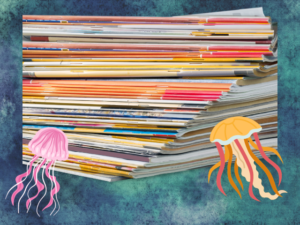
Trying to Organize Magazine Clutter
Clutter can be organized and I tried to do that. There was no more room for yet another shelf in the office/guest bedroom. It was already packed with decorating, architecture and philosophy books. So my idea was to go through each issue, clipping the articles I wanted to keep, stapling them and filing them in envelopes marked “Recipes,” “Ideas,” “Good Design,” and “Bad Design.” (Unlike other magazines, Martha Stewart Living had little to contribute to the “Bad Design” file.) After more than fifty hours of this, I’d only managed to reduce my Martha inventory by about 20%. It was exhausting. You can’t do more than a few issues a day. Don’t ask me why.
Anyway, I don’t have that kind of time. I have an old house to attend to. Unlike Martha, I must paint my 150-year-old windows myself, tend to eight gardens and stain my own decks. There are pickles to be made, beans and peaches to be picked and I spend a great deal of time editing my book. Old floors must have attention and, of course, twice a year I make a double portion of Martha’s onion soup for the freezer.
My husband and I are not strangers to the magazine-collecting dilemma. I became aware of the pitfalls when it took us eight years to divest ourselves of his old copies of The Smithsonian and The National Geographic.
But All These ‘Marthas’!!!
Never have I let a magazine situation get so out of hand. I remember in 2000, a new magazine called Real Simple came out. It’s a great read, packed with hints on how to make life’s chores (cleaning, beauty and cooking) less demanding. After buying six issues, I realized the irony: the burgeoning pile was getting me away from “simple.” The more simplicity tips I collected, the less simple my environment got. So I decided to discard Real Simple immediately after reading it, or peruse it in the doctor’s office without bringing it home.
In my book, I write about the eye movements of perception and how they outline a subliminal pattern. My intuition tells me that patterns that duplicate forms in nature cause a subtle positive energy in the environment. That intuition also tells me that the discordant patterns of clutter produce energy-depleting eye movements.
I know of many ways to contain clutter which fool the eye into thinking it sees a serene picture. I will share them in future blogs. There is a point, however, when the sheer number of items defeats my best eye-deceiving strategies.
Good Reasons to Deplore Clutter
1. Psychologically, clutter creates an ADD environment. It also causes self- reproach with the evidence of unfinished projects and a general feeling of being out of control.
2. Physically, clutter makes it easier to lose one’s glasses, checkbook or keys. In a maze of clutter, it’s more difficult to keep the home clean. Clutter adds a hazardous environment as one could trip over all the junk on the floor.
3. Economically, clutter is a disaster. The cost to the average disorganized American household is 15-20% of the household budget. This includes late fees and last minute premium prices. Clutter and too many “possessions” causes an estimated 40% more time spent on housework, another financial drain. (Reader Digest, May 2002)
4. Sociologically, exterior clutter in the form of litter causes crime rates to go up.
5. Eastern thought, like Feng Shui would say that the flow of the life giving energy, chi is impeded by clutter.
6. In the quantum world, the potentiality of energy is more important than the matter it creates; Einstein referred to this power of space over things when he said, “There is no place in the new kind of physics both for the field and matter. For the field is the only reality.”
7. The American koan reminds us that “less is more.” The Tao Te Ching tells us that we shape clay into a pot, but it is the emptiness inside that holds whatever we want.
Well, that is all very well and good, but what if we want our pots to hold Martha’s onion soup?
*****
So here’s my best clutter -reducing tip: do as I say and not as I do. Practice good “magazine hygiene.”
Apart from the clutter, the biggest problem with saving back issues is that you can’t remember which one featured the article you want to consult. (Martha Stewart Living published an index from 2002 to 2005 but stopped after that.) So create your own index by filing your favorite articles. After reading a magazine, rip out the articles you want to keep. Then staple them and slip them into the appropriately labeled envelope or file folder. Start now. Don’t wait twenty years.
***
There are two parts to this website, The Lessons, which are more difficult in concept, and the blogs, which are lighter in nature.
A Lesson that relates to this blog is:
Please note that my website allows you to leave comments at the end of the blogs but not at the end of each lesson. If you have a comment or question about a lesson, you may email me at ruta@rutas-rules.com
